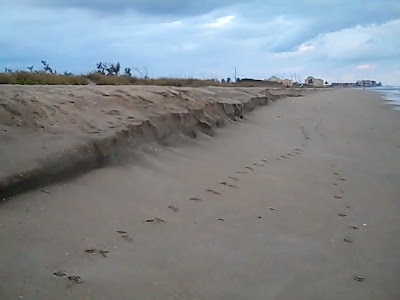 Cut at Low Tide This Morning.
Cut at Low Tide This Morning.A few days ago the beach south of Jensen Beach was eroded as shown in this photo. There were a lot of clad coins at this cut. One reader worked it a couple of days and took out a lot of clads.
I visited the spot this morning to see what it looked like now that the wind had shifted. As you can see the cut is still there but there wasn't much to be found directly in front of the cut.
What I did is what I talked about yesterday. I went outside the area that had already been cleaned up and found a good number of coins. The area south of the cut running for a couple hundred yards produced a coins in the wet sand at low tide.
There was a huge log (about 40 feet long and big around) that moved a couple hundred yards down the beach. That illustrates how quickly and how far wood or sections of a hull could travel along a beach.
I'm often surprised to find how many coins can still be found on our beaches. You just have to hunt out the right spots. I know that clad coins are not exciting, but they are out there. And when you find good concentrations of coins you can often find something else more interesting in between in them.
My experience this morning illustrated very well what I talked about yesterday.
After visually scanning a beach to find the best areas to check first, do some sampling. Run a loose scan and check to see what kinds of things are in the area. If the sample provides evidence of more good things in the area, tighten your pattern and hunt it better. If the sample isn't promising, move on and sample some other areas until you find a more promising place to hunt.
That applies to any type of beach hunting. Sample some areas before you decide where to focus your time.
The more you look at and the more you know about what is going on, the better off you will be.
Even knowing where the cuts are now, even if they are filling in to some extent, is a good thing to know. They can easily cut again. When there is a lot of sand on a beach, it will take more for it to cut.
When you dig a hole, notice the layers, if there are any. Become familiar with the type of sand that usually contains different types of targets at a particular beach.
You'll often notice that the coins you dig tend to be in a particular layer. That was the case today. The top layer was brown sand and then under that was a hard-packed grey layer of sand.
Here is a link to an article about a Chinese counterfeiting ring. They are manufacturing a variety of silver coins. The article has a lot of photos including the dies used to make the coins. I found it interesting.
http://coins.about.com/od/worldcoins/ig/Chinese-Counterfeiting-Ring/
Silver has been doing even better than gold on a percentage basis.
Here is a link to an article on metals investing.
http://www.coinnews.net/2010/12/28/gold-tops-1400-silver-jumps-above-30/
Forecast and Conditions.
As I mentioned the wind shifted and is now out of the southeast. Seas are relatively smooth, which gives you a chance to easily hunt the wet sand at low tide.
There are some cuts left and even though they are partially filled, you can still take advantage of whatever is left in the low tide areas around the cuts.
It doesn't look like there will be much change this week.
Happy hunting,
TreasureGuide@comcast.net